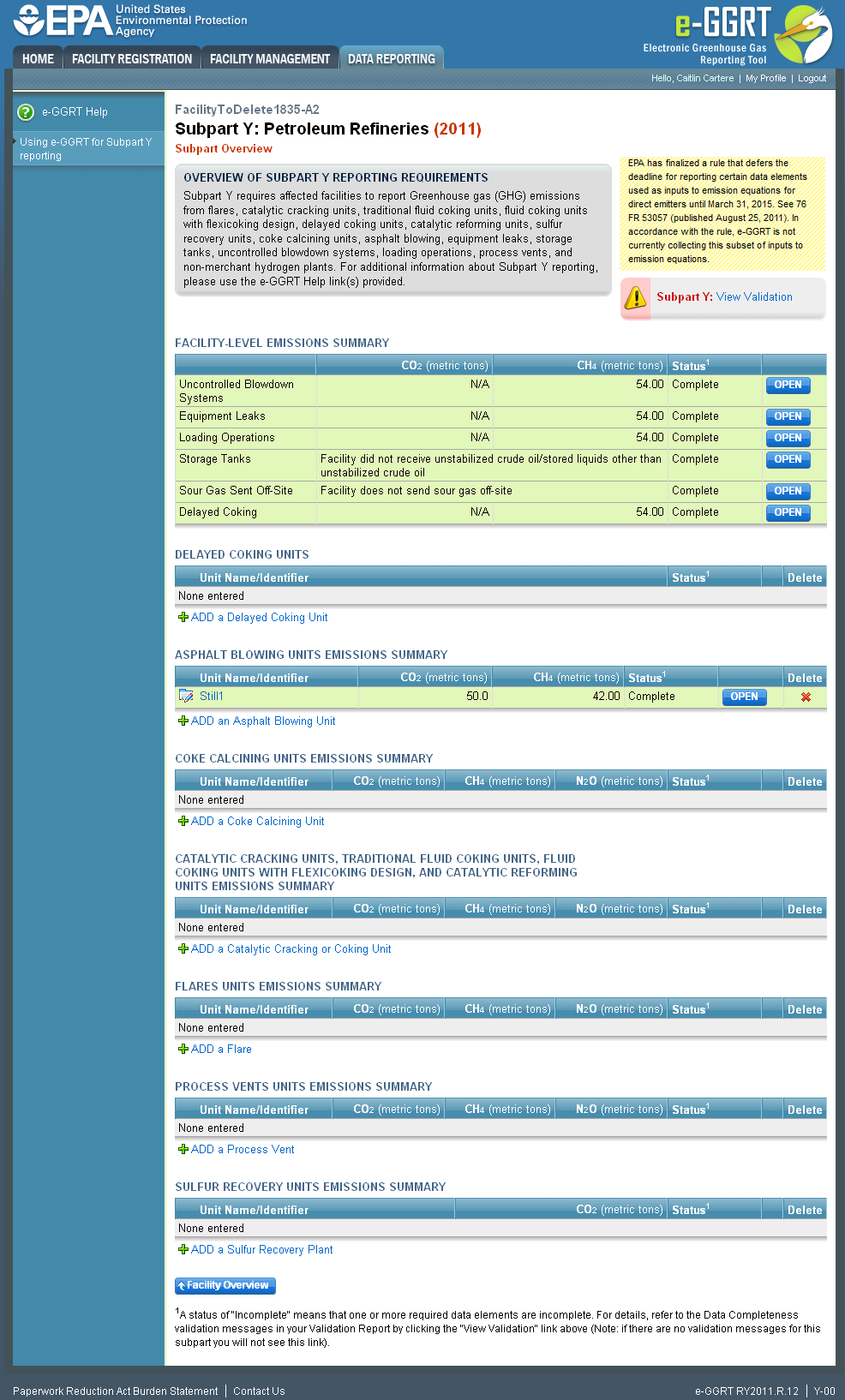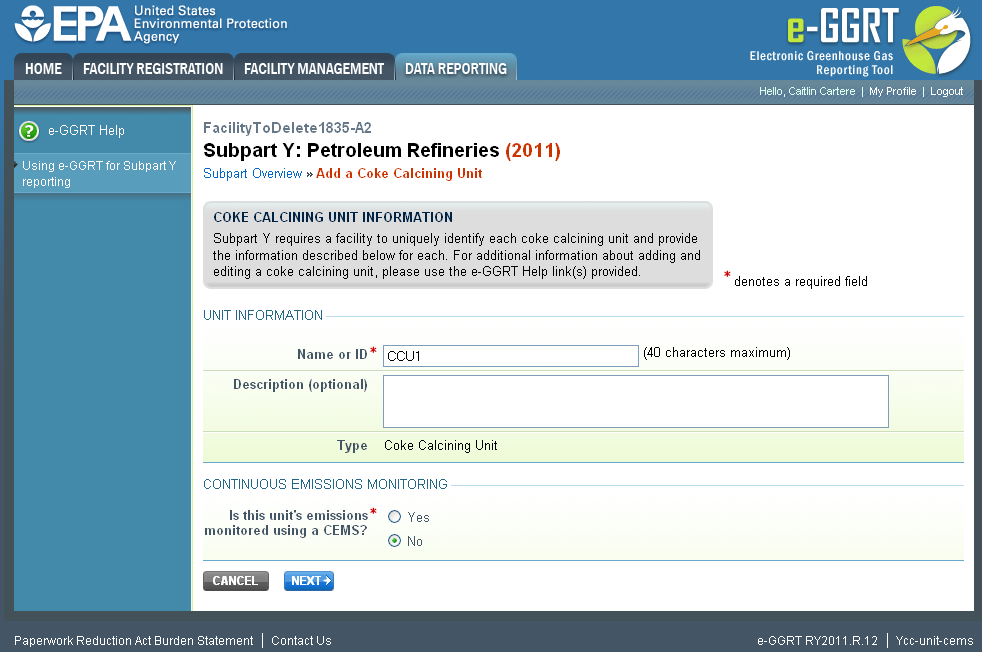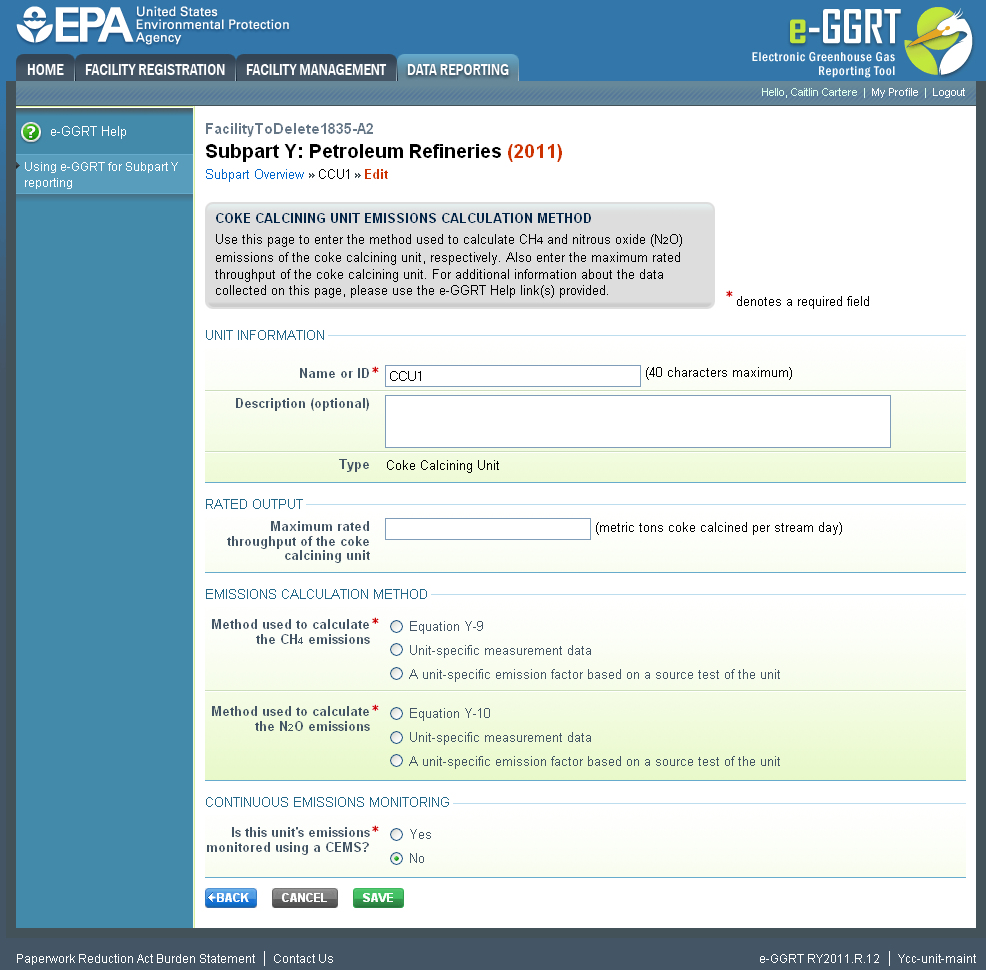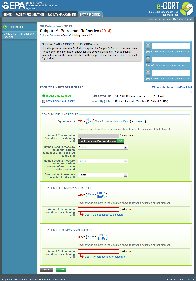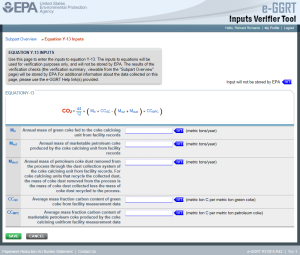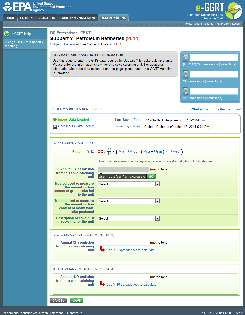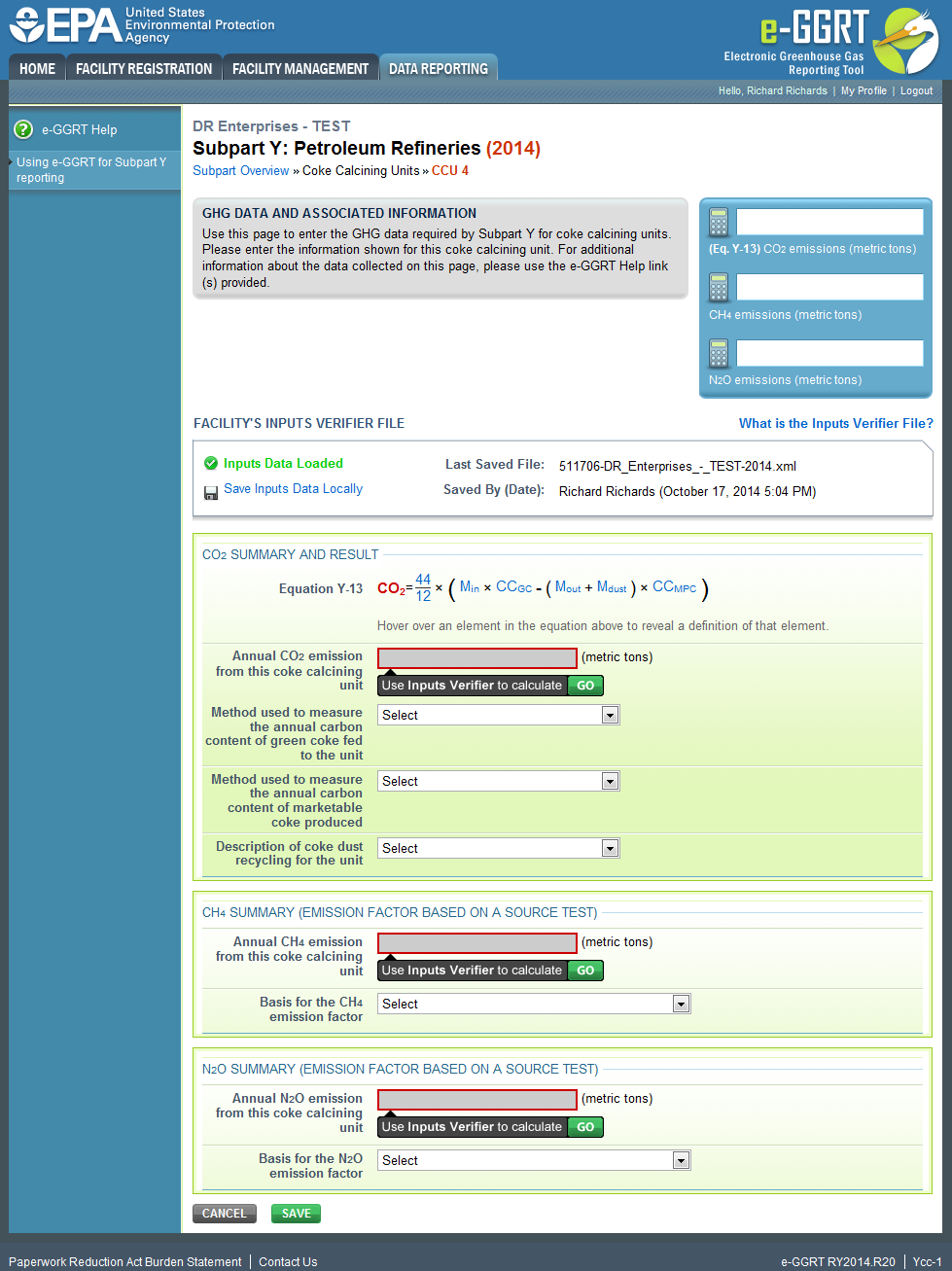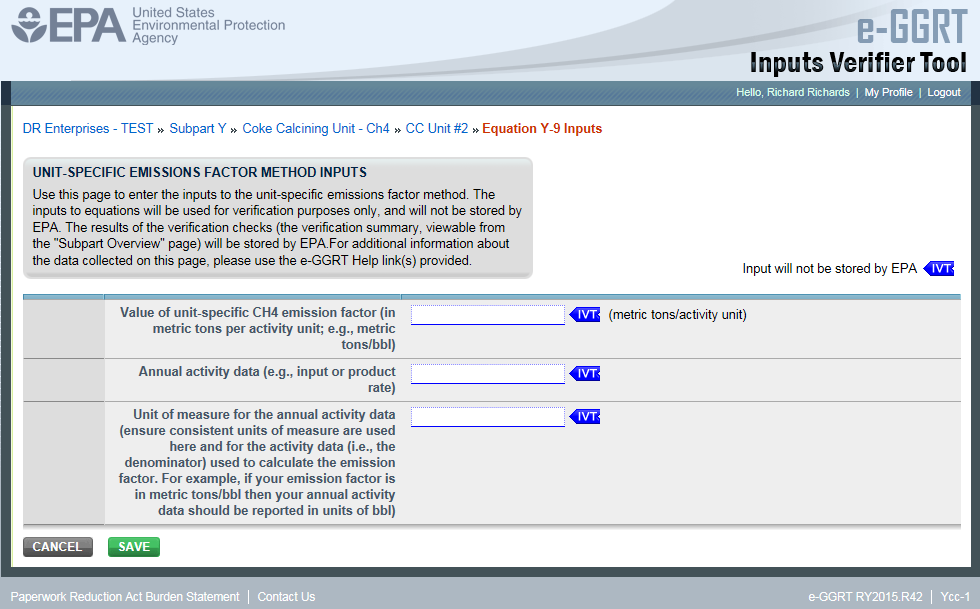This topic provides a step-by-step description of how to enter Subpart Y Coke Calcining unit information about this facility.
Click this link to expand
Adding or Updating Coke Calcining Unit Information
To add or update Subpart Y Coke Calcining Unit Information for this Facility, locate the COKE CALCINING UNIT-LEVEL EMISSIONS SUMMARY table on the Subpart Y Overview page.
Click the link titled "ADD a Coke Calcining Unit."
To edit an existing Coke Calcining Unit, click on the edit icon or the Name/ID link, which is the first column in the COKE CALCINING UNIT-LEVEL EMISSIONS SUMMARY table.
To delete an existing Coke Calcining Unit, click on the delete icon, which is the last column in the COKE CALCINING UNIT-LEVEL EMISSIONS SUMMARY table.
Click this link to expand
Subpart Y requires you to report the following data about your coke calcining unit:
- A unique name or identifier, plus optional description for this coke calcining unit. See also About Unique Unit Names
- For each unit, answer the following question: “Do you operate and maintain a Continuous Emissions Monitoring System (CEMS) that measures CO2 emissions according to subpart C? This means you have both a flow meter and a concentration monitor installed. If so, you must use the CEMS methodology. Click either Yes or No.
When you are finished, click NEXT.
If you selected Yes for using a CEMS, Subpart Y collects the maximum rated throughput of the coke calcining unit (metric tons coke calcined per stream day)
Click this link to expand
If you select No for using a CEMS, Subpart Y collects the following data about your coke calcining unit:
When you are finished, click SAVE.
Adding or Updating Coke Calcining Emissions Information
The following provides a step-by-step description of how to enter Subpart Y Coke Calcining emissions information.
Click this link to expand
To add or update CO2 emissions information for a coke calcining unit that is monitored by CEMS, please refer to the Subpart Y Emissions Information for Process Units Monitored by CEMS help page (CH4 and N2O emissions information for coke calcining units that are monitored by CEMS are reported separately per the instructions below).
To add or update CO2, CH4, and N2O emissions information for a coke calcining unit that is NOT monitored by CEMS OR CH4 and N2O emissions information for a coke calcining unit that is monitored by CEMS, locate the COKE CALCINING UNIT-LEVEL EMISSION SUMMARY table on the Subpart Y Overview page, and click OPEN.
Click this link to expand
Step 1. CO2 Emissions: Equation Y-13 Summary and Result (for Units NOT Monitored by CEMS)
Step 1 does not apply to units monitored by CEMS. If you are reporting for a unit monitored by CEMS, please skip to Step 2a.
Equation Y-13, which calculates the annual CO2 emissions from coke calcining operations is presented in the CO2 SUMMARY AND RESULT section of the page. You can hover over an element in the equation to reveal a definition of that element. Reporting the annual CO2 emissions from coke calcining operations is required and must be calculated using the IVT module.
Also in the CO2 SUMMARY AND RESULT section, you will find a data entry cell labeled "Annual CO2 emissions from this coke calcining unit." Immediately below this data entry cell you will see a block labeled "Use Inputs Verifier to calculate" and a green GO button. To open the IVT module for Equation Y-13, click GO. See Subpart Y Entering Equation Inputs Using IVT for instructions on using the IVT modules, including the important steps of loading and saving your inputs verifier file.
Click this link to expand
Enter the following information in the IVT module:
- Annual mass of green coke fed to the coke calcining unit from facility records (metric tons/year)
- Annual mass of marketable petroleum coke produced by the coke calcining unit from facility records (metric tons/year)
- Annual mass of petroleum coke dust removed from the process through the dust collection system of the coke calcining unit from facility records. For coke calcining units that recycle the collected dust, the mass of coke dust removed from the process is the mass of coke dust collected less the mass of coke dust recycled to the process. (metric tons/year)
- Average mass fraction carbon content of green coke from facility measurement data (metric ton C per metric ton green coke)
- Average mass fraction carbon content of marketable petroleum coke produced by the coke calcining unit from facility measurement data (metric ton C per metric ton petroleum coke)
Click SAVE to return to the Coke Calcining Units Emissions page. The value calculated by the IVT module will be displayed in the IVT result data cell. Below this a checkbox labeled “Enter/Report Alternate Result" will be displayed. Checking this checkbox will cause a data entry cell labeled “Enter Own Result” to appear in which you may enter a value that you consider to be more accurate than the one calculated by the IVT module.
Subpart Y requires the following additional data:
- Method used to measure the annual carbon content of green coke fed to the unit selected from the following options:
- ASTM D3176-89-Reapproved 2002
- ASTM D5291-02-Reapproved 2007
- ASTM D5373-08
- Other (specify)
- Method used to measure the annual carbon content of marketable coke produced selected from the following options:
- ASTM D3176-89-Reapproved 2002
- ASTM D5291-02-Reapproved 2007
- ASTM D5373-08.
- Other (specify)
- Description of coke dust recycling for the unit selected from the following options:
- All dust is recycled
- A portion of the dust is recycled
- None of the dust is recycled
Step 2. CH4 and N2O Emissions
Depending on the method selected to calculate the CH4 and N2O emissions for coke calcining units, some combination of the screens presented below (Steps 2a, 2b and 2c) will collect CH4 and N2O emissions.
Step 2a: Equation Y-9/Y-10 Summary and Result
Click this link to expand
The annual CH4 and N2O emissions from coke calcining operations are required. To calculate these values download the appropriate spreadsheet by clicking the link titled “Use Y-9 spreadsheet to calculate” for CH4 or “Use Y-10 spreadsheet to calculate” for N2O. Fill in the spreadsheet using the instructions in the spreadsheet. After completing each respective spreadsheet, copy the value of CH4 and N2O calculated by the spreadsheet to this page in the box next to “Annual CH4 emission from this coke calcining unit (metric tons)” or “Annual N2O emission from this coke calcining unit (metric tons),” as appropriate.
The Equation Y-9/Y-10 Summaries are presented on the page. You can hover over an element in the equation to reveal a definition of that element.
Step 2b: Unit-specific Measurement Result
Click this link to expand
The annual CH4 and N2O emissions from coke calcining operations are required. Enter the value of CH4 and N2O in this page in the box next to “Annual CH4 emission from this coke calcining unit (metric tons)” or “Annual N2O emission from this coke calcining unit (metric tons),” as appropriate.
Step 2c: Unit-specific Emission Factor Based on a Source Test Result
The annual CH4 and N2O emissions from coke calcining operations are required and must be entered using the IVT module. Access the IVT module for calculating CH4 emissions from coke calcining operations where the emission factor is based on a source test by clicking the GO button in the box labeled "Use Inputs Verifier to calculate" box immediately beneath the "Annual CH4 emissions from this coke calcining unit" data entry cell. This will open the Equation Y-9 Alternative Inputs module.
Click this link to expand
See Subpart Y Entering Equation Inputs Using IVT for instructions on using the IVT modules, including the important steps of loading and saving your inputs verifier file. Enter the following information in the IVT module to calculate CH4 emissions and click SAVE:
- Value of unit-specific CH4 emission factor (in metric tons per activity unit; e.g., metric tons/bbl)
- Annual activity data (e.g., input or product rate)
- Unit of measure for the annual activity data (ensure consistent units of measure are used here and for the activity data (i.e., the denominator) used to calculate the emission factor. For example, if your emission factor is in metric tons/bbl then your annual activity data should be reported in units of bbl).
Click this link to expand
The Equation Y-10 Alternative Inputs IVT module for calculating N2O emissions is accessed in a similar fashion by clicking the GO button beneath the data entry cell labeled "Annual N2O emissions from this coke calcining unit." Enter the following information into the Equation Y-10 Alternative Inputs IVT module and click SAVE:
- Value of unit-specific N2O emission factor (in metric tons per activity unit; e.g., metric tons/bbl)
- Annual activity data (e.g., input or product rate)
- Unit of measure for the annual activity data (ensure consistent units of measure are used here and for the activity data (i.e., the denominator) used to calculate the emission factor. For example, if your emission factor is in metric tons/bbl then your annual activity data should be reported in units of bbl).
When you have completed entering information in the IVT modules, report the basis for the CH4 and N2O emissions factors from the following options in the dropdown box provided for each emission factor:
- Weekly or more frequent measurements
- Periodic (less frequent than weekly) measurements
- Average of multiple source tests
- One-time source test
- Other (specify)
When you have finished entering data in an IVT module, click SAVE to return to the GHG DATA AND ASSOCIATED INFORMATION page for the Coke Calcining unit. The value calculated by the IVT module will be displayed in the IVT result data cell. Below this a checkbox labeled “Enter/Report Alternate Result” will be displayed. Checking this checkbox will cause a data entry cell labeled “Enter Own Result” to appear in which you may enter a value that you consider to be more accurate than the one calculated by the IVT module.
Step 3: Save Your Data
When you have finished entering emission results, click SAVE.
After you save the data on this page, the next time you open the page, the calculators on the top of the page will display the CO2, CH4 and N2O emissions, rounded to the nearest 0.1, 0.01, and 0.001 of a metric ton, respectively. The value displayed is for informational purposes only.
See Also
Screen Code
Using e-GGRT to Prepare Your Subpart Y Report
- Subpart Y Summary Information for this Facility
- Subpart Y Asphalt Blowing Unit Information for RY2018 and Later Years
- Subpart Y Delayed Coking Unit Information
- Subpart Y Asphalt Blowing Unit Information
- Subpart Y Asphalt Blowing Unit Information for RY2014 - RY2017
- Subpart Y Coke Calcining Unit Information
- Subpart Y Catalytic Cracking, Fluid Coking, and Catalytic Reforming Unit Information
- Subpart Y Delayed Coking Unit Information for RY2018 and Later Years
- Subpart Y Delayed Coking Unit Information for RY2014 - RY2017
- Subpart Y Flares Unit Information
- Subpart Y On-Site Sulfur Recovery Plant Information
- Subpart Y Process Vents Unit Information
- Subpart Y Emissions Information for Process Units Monitored by CEMS
- Subpart Y Entering Equation Inputs Using IVT
- Subpart Y IVT Equation Inputs Summary
- Using Subpart Y Calculation Spreadsheets


